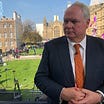Long live the King! Or rather, since the words will be in ceremonial Latin, “Vivat Rex!”. It is the jealously guarded role of the scholars of Westminster School to be the first to salute a new Monarch the moment the crown first touches their head during the coronation service at Westminster Abbey.
King Charles III’s coronation is still many months away and the role of the public school boys has yet to be confirmed in this egalitarian age. Not to mention whether there will be a place for the sixth form girl scholars, recently introduced at the school. The pupils have been involved in the coronation as representatives of the people since at least James II. But in 1902, the Head Master had to appeal to the Court of Claims to ensure they took part in the ceremony for Edward VII. The. School was greatly relieved when Sir Herbert Parry wrote their part into his version of Psalm 122 which has become standard for coronations.
I was a Westminster Scholar in the mid 1970s with absolutely no expectation that my services would be called upon. Our duties were reduced to occasionally donning second hand tail coats and surpluses from a dressing up cupboard to act as ushers in the Abbey. At the Order of the Bath ceremony, the Queen, utterly in command, processed past us down the aisle. It was no surprise that she had a half century of vigorous reign ahead of her.
Now it is all change. Westminster’s Queen’s Scholars – QSS – in the school jargon – have become KSS, just as QCs in the inns of court have already been told they are now KCs. Nobody will be able to escape the tangible manifestations of the succession. New coins will be minted. By tradition, King Charles’. Profile will face to the left the opposite direction of his predecessor. They’ll be a new silhouette on Royal Mail stamps and the Royal Mint may be reconsidering the wisdom of its recently introduced long-life bank notes.
The national mood will enter a new phase as well. The Queen has been a reassuringly constant presence in our lives as long as anyone can remember. She performed her duties with total reliability, displaying an intelligent interest in everything she encountered without revealing her personal opinions, assuming that she did not suppress them out of existence. Her children, including her eldest son, have not been so successful either at hiding their emotions or keeping their private lives on the regal straight and narrow.
But this is now a more touchy-feely age, brought about in part by another Royal death. In magnitude of impact, the nearest parallel to the current events in news terms is the aftermath of the death of Princess Diana. Sincerely mourned though they were, the demises of the Queen Mother and the Duke of Edinburgh did not have a comparable impact on the public. But where the violent loss of Diana, a young mother in her prime, inspired shock, grief and anger, the passing of the longest serving monarch has led to a celebration of her long life of service.
The Royal family’s hesitant public response to Diana’s death was one of the low points of the Queen’s reign, only rectified when she returned from Balmoral to Buckingham Palace, made her live address and met the mourners massing at the railings.
There were echoes of that walkabout when the new King returned to London from Scotland. But he and Camilla wasted no time, they got straight out of their state limousine to greet the crowds. He is a monarch for our times.
Some of her Majesty’s warmest admirers are suggesting she should be remembered as “Elizabeth the Great”. Elizabeth II is awkward in some of her realms, especially Scotland which was never ruled by Elizabeth I, the Virgin Queen. The new nickname is meant as a tribute perhaps evoking that other consequential monarch such as Catherine the Great. There is no need for it. Elizabeth has so epitomised the brand, I suspect that she will be forever known around the world as simply “The Queen”, whoever else occupies the female regal role around the world. Charles III will truly have been embraced by the nation when he can simply be referred to as “The King”, without the need for qualification.
“Royal watchers” are now telling us that Balmoral was the Queen’s favourite home. I doubt she ever expressed such a preference. Buckingham Palace may have been viewed as “the Office” but she seemed to have a genuine affection for Windsor Castle, the closest place she had to a childhood home. She and her husband spent much of Prince Philip’s declining years at Sandringham in Norfolk where they seemed to find it easiest to lead a “normal” private life.
Sticking to her annual progress she went to Scotland for the summer. Her decision to stay there when she may have had inclinations of declining powers was pointed, becoming significant when she declined to come south for the transition of the Premiership between Johnson and Truss. Metropolitan mainstream commentators betrayed their prejudices when they branded this a break with tradition. She had always stressed that she was Queen of the United Kingdom and Northern Ireland, of which Scotland is of course an equal part. That fact will be advertised to all thanks to Operation Unicorn, annexed to Operation London Bridge, which comes into force because of where she died. Holyrood Palace, St Giles Cathedral and Waverley Station in Edinburgh will all be prime locations during this period of mourning and a reminder that, according to David Cameron, the Queen “purred” when he informed her Scotland had voted ‘No’ to independence.










